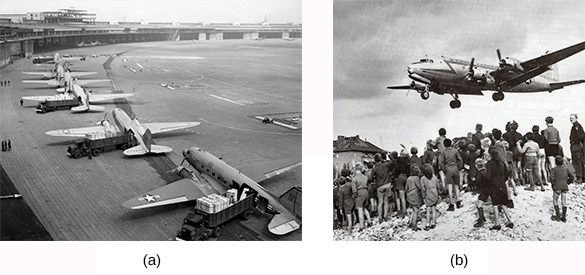| << Chapter < Page | Chapter >> Page > |
The lack of consensus with the Soviets on the future of Germany led the United States, Great Britain, and France to support joining their respective occupation zones into a single, independent state. In December 1946, they took steps to do so, but the Soviet Union did not wish the western zones of the country to unify under a democratic, pro-capitalist government. The Soviet Union also feared the possibility of a unified West Berlin, located entirely within the Soviet sector. Three days after the western allies authorized the introduction of a new currency in Western Germany—the Deutsche Mark—Stalin ordered all land and water routes to the western zones of the city Berlin to be cut off in June 1948. Hoping to starve the western parts of the city into submission, the Berlin blockade was also a test of the emerging U.S. policy of containment.
Unwilling to abandon Berlin, the United States, Great Britain, and France began to deliver all needed supplies to West Berlin by air ( [link] ). In April 1949, the three countries joined Canada and eight Western European nations to form the North Atlantic Treaty Organization (NATO), an alliance pledging its members to mutual defense in the event of attack. On May 12, 1949, a year and approximately two million tons of supplies later, the Soviets admitted defeat and ended the blockade of Berlin. On May 23, the Federal Republic of Germany (FRG), consisting of the unified western zones and commonly referred to as West Germany, was formed. The Soviets responded by creating the German Democratic Republic, or East Germany, in October 1949.

In 1949, two incidents severely disrupted American confidence in the ability of the United States to contain the spread of Communism and limit Soviet power in the world. First, on August 29, 1949, the Soviet Union exploded its first atomic bomb—no longer did the United States have a monopoly on nuclear power. A few months later, on October 1, 1949, Chinese Communist Party leader Mao Zedong announced the triumph of the Chinese Communists over their Nationalist foes in a civil war that had been raging since 1927. The Nationalist forces, under their leader Chiang Kai-shek, departed for Taiwan in December 1949.
Immediately, there were suspicions that spies had passed bomb-making secrets to the Soviets and that Communist sympathizers in the U.S. State Department had hidden information that might have enabled the United States to ward off the Communist victory in China. Indeed, in February 1950, Wisconsin senator Joseph McCarthy, a Republican, charged in a speech that the State Department was filled with Communists. Also in 1950, the imprisonment in Great Britain of Klaus Fuchs, a German-born physicist who had worked on the Manhattan Project and was then convicted of passing nuclear secrets to the Soviets, increased American fears. Information given by Fuchs to the British implicated a number of American citizens as well. The most infamous trial of suspected American spies was that of Julius and Ethel Rosenberg, who were executed in June 1953 despite a lack of evidence against them. Several decades later, evidence was found that Julius, but not Ethel, had in fact given information to the Soviet Union.

Notification Switch
Would you like to follow the 'U.s. history' conversation and receive update notifications?